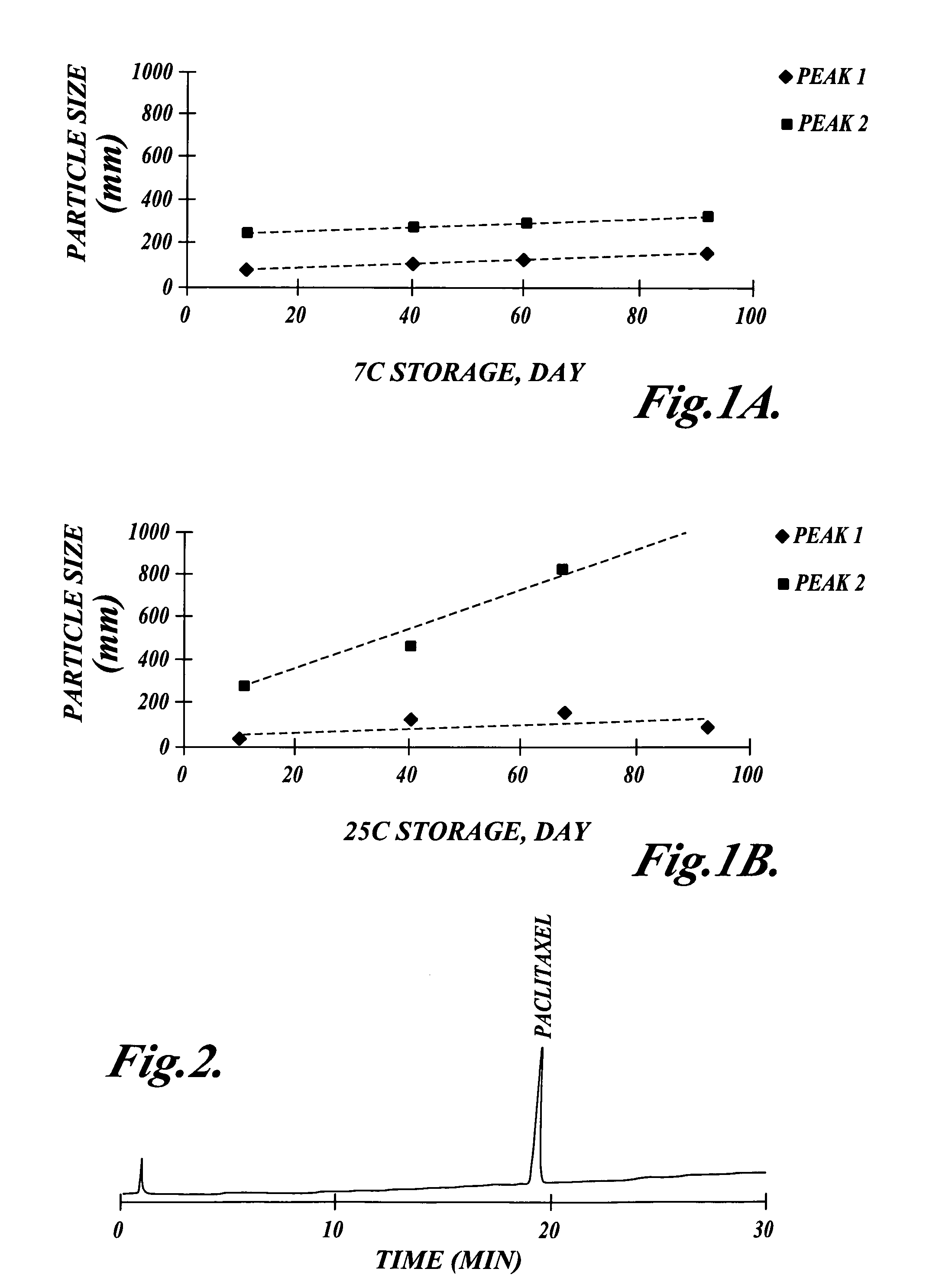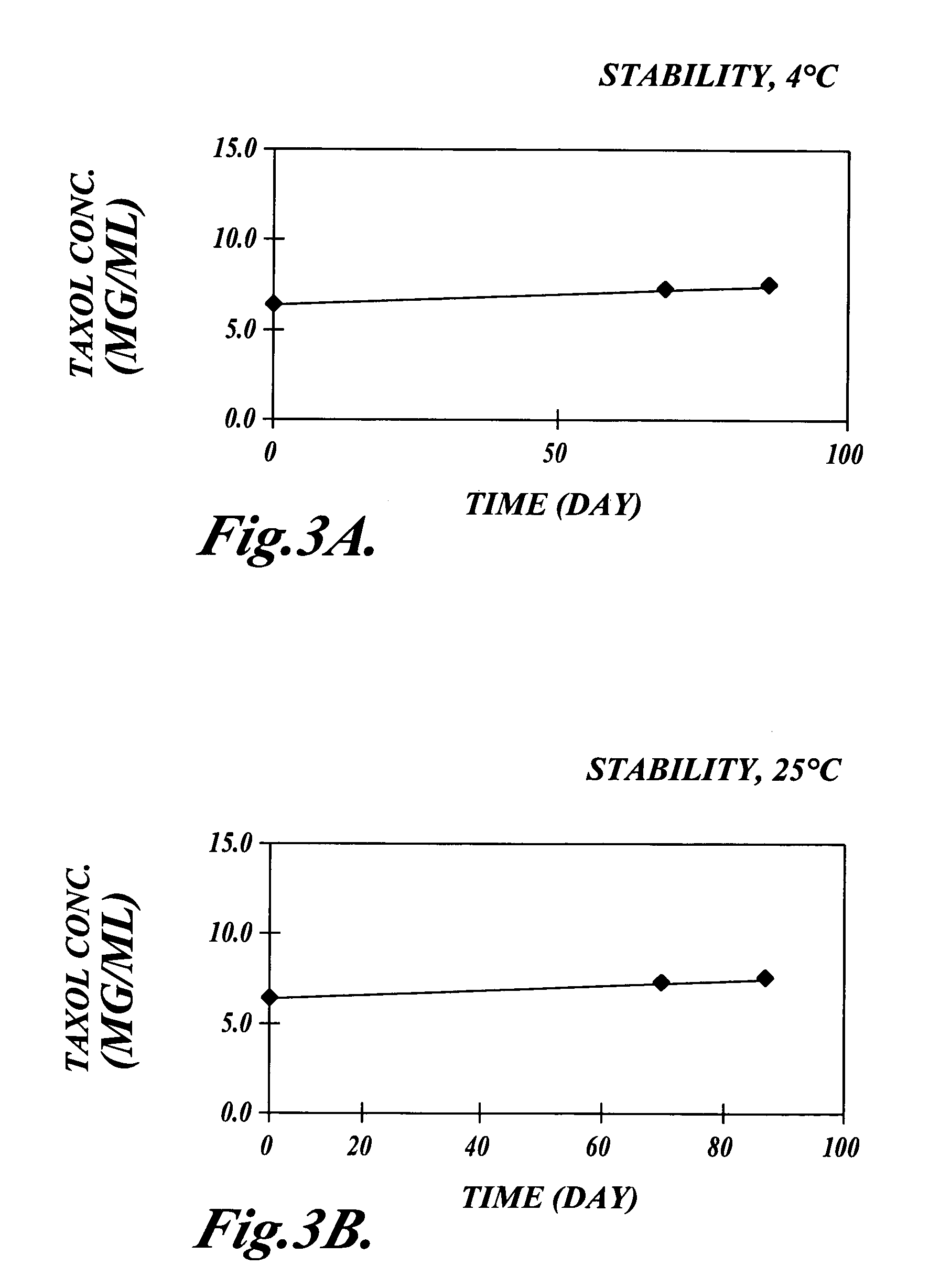Emulsion vehicle for poorly soluble drugs
a poorly soluble, emulsion technology, applied in the direction of application, drug composition, biocide, etc., can solve the problems of affecting the stability of emulsion, and affecting the effect of emulsion stability
- Summary
- Abstract
- Description
- Claims
- Application Information
AI Technical Summary
Benefits of technology
Problems solved by technology
Method used
Image
Examples
example 1
Dissolution of Paclitaxel in α-tocopherol
[0073]α-Tocopherol was obtained from Sigma Chemical Company (St Louis Mo.) in the form of a synthetic dl-α-tocopherol of 95% purity prepared from phytol. The oil was amber in color and very viscous. Paclitaxel was purchased from Hauser Chemical Research (Boulder Colo.), and was 99.9% purity by HPLC. Paclitaxel 200 mg was dissolved in 6 mL of dry absolute ethanol (Spectrum Chemical Manufacturing Corp, Gardena Calif.) and added to 1 gm α-tocopherol. The ethanol was then removed by vacuum at 42° C. until the residue was brought to constant weight. Independent studies showed that the ethanol content was less than 0.3% (w / v).
[0074]The resultant solution was clear, amber and very viscous, with a nominal concentration of 200 mg / gm (w / w) paclitaxel in α-tocopherol. Higher concentrations of Paclitaxel (up to 400 mg / gm, w / w) can be solubilized in α-tocopherol.
example 2
Anionic Surfactant Used to Prepare α-tocopherol Emulsions
[0075]Paclitaxel 2 gm in 10 gm of α-tocopherol, prepared as described in Example 1, was emulsified with ascorbyl palmitate as the triethanolamine salt by the following method. A solution consisting of ascorbic acid 20 mM was buffered to pH 6.8 with triethanolamine as the free base to from 2× buffer. 50 mL of the 2× buffer was placed in a Waring blender. 0.5 gm of ascorbyl-6-palmitate (Roche Vitamins and Fine Chemicals, Nutley N.J.), an anionic surfactant, was added and the solution blended at high speed for 2 min at 40° C. under argon. The α-tocopherol containing paclitaxel was then added into the blender with the surfactant and buffer. Mixing was continued under argon until a coarse, milky, pre-emulsion was obtained, approximately after 1 min at 40° C. Water for injection was then added, bringing the final volume to 100 mL.
[0076]The pre-emulsion was transferred to the feed vessel of a Microfluidizer Model 110Y (Microfluidics ...
example 3
Use of PEGylated Vitamin E (TPGS)
[0079]A ternary phase diagram was constructed for α-tocopherol, PEGylated vitamin E (TPGS, vitamin-E polyoxyethyleneglycol-1000-succinate, obtained from Eastman Chemical Co., Kingsport Tenn.), and water. TPGS was first melted at 42° C. and mixed gravimetrically with α-tocopherol at various proportions from 1 to 100% TPGS, the balance being α-tocopherol. Mixtures were miscible at all concentrations. Water was then added to each mixture in such a way that the final water concentration was increased stepwise from zero to 97.5%. At each step, observations were made of the phase behavior of the mixture. As appropriate, mixing was performed by vortexing and sonication, and the mixture was heated or centrifuged to assess its phase composition.
[0080]A broad area of biphasic o / w emulsions suitable for parenteral administration was found at water concentrations above 80%. The emulsions formed were milky white, free flowing liquids that contained disperse α-toc...
PUM
| Property | Measurement | Unit |
|---|---|---|
| concentration | aaaaa | aaaaa |
| concentration | aaaaa | aaaaa |
| concentration | aaaaa | aaaaa |
Abstract
Description
Claims
Application Information
 Login to View More
Login to View More - R&D
- Intellectual Property
- Life Sciences
- Materials
- Tech Scout
- Unparalleled Data Quality
- Higher Quality Content
- 60% Fewer Hallucinations
Browse by: Latest US Patents, China's latest patents, Technical Efficacy Thesaurus, Application Domain, Technology Topic, Popular Technical Reports.
© 2025 PatSnap. All rights reserved.Legal|Privacy policy|Modern Slavery Act Transparency Statement|Sitemap|About US| Contact US: help@patsnap.com



